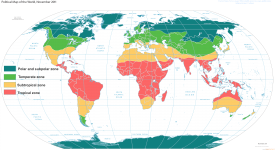Climate zones

Climate zones are areas with distinct climates, which occur in east-west direction around the Earth, and can be classified using different climatic parametres. Generally, climate zones are belt-shaped and circular around the Poles (see picture on the right). In some areas, climate zones can be interrupted by mountains or oceans.
The solar radiation reaches the ground on different parts of the Earth with different angles. On the equator, the sunlight reaches the ground almost perpendicularly, whilst at the poles the angle of the Sun is lower or even under the horizon during the polar night.

Throughout the seasons, the position of the Sun
to the Earth and thus the angle of incidence of the sunlight also change. The angle of the Sun at noon varies from
perpendicular (90°) within the tropics up to horizontal (0° = Sun does not or only partially appear on the horizon)
within the polar circle. Thus, the sunlight warms up the Earth around the equator much more strongly than at the
poles. Due to temperature differences caused by the differences in
radiation, recurring climatic conditions develop, such as winter and summer. These conditions are characterised by a
certain amount of precipitation in summer or a certain average air temperature.
Different climatic conditions,
which arise regularly in certain areas, are summarised and described in the classification below.
Classification
There are 4 major climate zones:
- Tropical zone from 0°–23.5°(between the
tropics)
- In the regions between the equator and the tropics (equatorial region), the solar radiation reaches the ground nearly vertically at noontime during almost the entire year. Thereby, it is very warm in these regions. Through high temperatures, more water evaporates and the air is often moist. The resulting frequent and dense cloud cover reduces the effect of solar radiation on ground temperature.
- Subtropics from 23.5°–40°
- The subtropics receive the highest radiation in summer, since the Sun's angle at noon is almost vertical to the Earth, whilst the cloud cover is relatively thin. These regions receive less moisture (see trade winds), what increases the effect of radiation. Therefore, most of the deserts in the world are situated in this zone. In winter, the radiation in these regions decreases significantly, and it can temporarily be very cool and moist.
- Temperate zone from 40°–60°
- In the temperate zone, the solar radiation arrives with a smaller angle, and the average temperatures here are much cooler than in the subtropics. The seasons and daylength differ significantly in the course of a year. The climate is characterised by less frequent extremes, a more regular distribution of the precipitation over the year and a longer vegetation period - therefore the name "temperate".
- Cold zone from 60°–90°
- The polar areas between 60° latitude and the poles receive less heat through solar radiation, since the Sun has a very flat angle toward the ground. Because of the changes of the Earth axis angle to the Sun, the daylength varies most in this zone. In the summer, polar days occur. Vegetation is only possible during a few months per year and even then is often sparse. The conditions for life in these regions are very hard.
The characteristics of the climate zones change with great altitude differences within a small area, like in mountain areas, since temperatures decrease rapidly with altitude, changing the climate compared to valleys.



